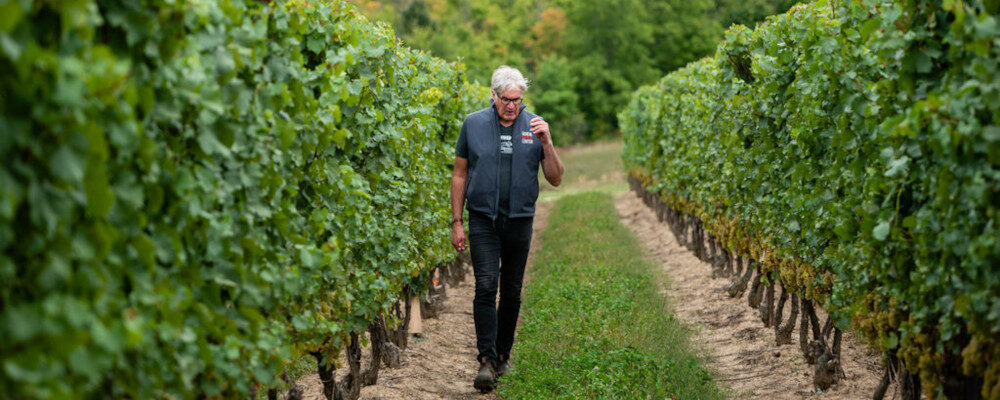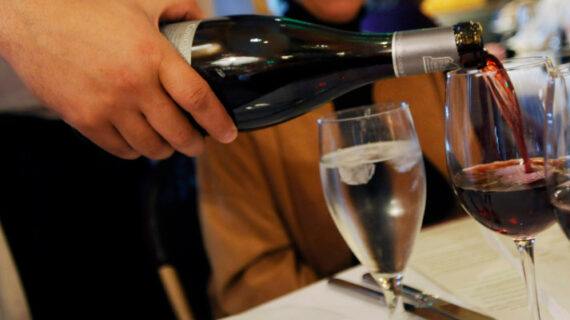Thomas Bachelder doesn’t make a lot of wine, he makes a lot of wines. These days that means making small lots of Pinot Noir and Chardonnay from organic vineyard sites spread around the Niagara Peninsula from the south shore of Lake Ontario to nearly the top of the Niagara Escarpment for his label, Bachelder Wines. He and his wife and partner in wine, Mary Delaney, buy grapes from established growers, often working off of a top from another winemaker, or patiently waiting for a row or two to become available.
A native Montrealer, Bachelder is among Canada’s most respected winemakers. After deciding he’d rather make wine than write about it, he and Delaney moved from Quebec to Burgundy where he studied and started making wine. After France, he went to Oregon and then Niagara to make wine for the Clos Jordanne project in the mid-2000s. From there he worked in other wineries and made Chardonnay and Pinot Noir under the Bachelder label in what became his three terroirs: Burgundy, Oregon, and Niagara.

The focus today is firmly on Niagara, where he and Mary established the home cellar they call their “Bat Cave”. There, they elevate the wines they began to source from around the Peninsula. This week they braved the traffic on the Queen Elizabeth Way to bring a bunch of their wines around the Golden Horseshoe for a trade and media tasting in Toronto featuring the wines from their Toussaint release.
When I got the invitation, I wondered if Toussaints was a new label the Delaney-Bachelders had developed. Only when I downloaded the 42-page catalogue1There are very detailed notes for all of the 19 wines in the Toussaint release in the catalogue, which is lovingly written by the wine writer turned maker, and can be downloaded at the Bachelder website: https://bachelderniagara.com/ did I understand it cleverly meant “all saints”, and the wines were officially released on November 1st. We would be tasting 19 wines from nearly as many places, plus a bonus wine: Bachelder’s 2020 Les Villages Bench Pinot Noir, which is a blend.
The tasting was held at Chez Nous, a wine bar on Queen East that serves only Ontario wines, beers, ciders, and spirits. The venue choice was deliberate, and Bachelder explained its owner, Laura Carr, had worked in hospitality all over the world before coming back to Canada with a view to exclusively celebrating what was here—a familiar theme.
Bachelder began the tasting by explaining its purpose. He hoped, he told our group of about a dozen, that we would walk out of the tasting with at least a sense of the difference between the Niagara Peninsula’s two general terroirs: the higher bench lands2“A bench or a ‘benchland’ is a long, narrow strip of relatively level land that is bounded by distinctly steeper slopes above and below it. Benches can be formed by many different geological processes, such as a river (as in a river’s flood plain, or an “abandoned” river bed), waves (if alongside an ocean), or the varying levels of erosion of different types of rock. https://bubblyprofessor.com/2013/07/04/geology-escarpment-and-bench/ up the Escarpment3“An escarpment is basically an area of the Earth where the elevation changes suddenly. An escarpment is often found along the ocean shore. https://bubblyprofessor.com/2013/07/04/geology-escarpment-and-bench/ itself and the lower lands closer to the shore of Lake Ontario. Of course, because this is wine, for every rule there is at least one exception, so we might also see how an individual site might defy typicity by, for instance, being very close to the water, or placed on a hill that faced a certain direction.
We began by tasting the 2020 Les Villages Niagara Escarpment Bench Pinot Noir. This wine is a blend of many, though not all, of the Pinot sites Bachelder sources from. It’s not technically part of the Toussaint release and was put into bottle earlier than the single-site wines. The idea was to give us a baseline and calibrate our senses into an idea of what the 2020 Niagara Pinot made by Bachelder would taste like. Bachelder’s boutique small-batch wines are not cheap, and he admitted as much by saying he is loath to call Les Villages an “entry-level wine” with a price tag of $35 a bottle. In any event, the wine was vibrant, bright, and fresh with red fruit, calling for food.
And then the whirlwind: eight single-site 2020 Pino Noirs. The first three from “the lake” in the flat lands north of the Queen Elizabeth towards the town of Niagara-on-the-Lake. Then five from “the bench”, up into the big hill of the Escarpment.
“I try to do the same thing with everything,” explained Bachelder. To poke out the differences between each vineyard, or even parcel within the same vineyard, the winemaker keeps to a relatively low intervention regime. There is about 20 percent new oak ageing in every wine, though this may vary somewhat depending on how many barrels are made.
A loyal disciple of the Burgundian tradition of wood and wine, Bachelder explained that every barrel is its own unique vessel, so despite trying to create control over the winemaking with each lot, two barrels of wine sourced from the same place, treated the same, and sitting next to each other in his Bat Cave may vary considerably. There is always winemaking work to be done, he seemed to say.
With the eight single-site Pinots, Bachelder’s lesson rang true. The lake wines tended to be a little bit fresher and fruitier, and the bench ones maybe a bit more concentrated, or showed some slightly darker cherry notes. Though to be honest, the same words appear in both groups in my notes a lot, so there is a golden thread of red fruit and liveliness that runs through them all.
If the Pinots were a whirlwind, then the 11 Chardonnays that followed, tasted second in the Burgundian tradition, were a hurricane. First, four lakes: crisp and mineral, showing lots of stone fruit. The Patte Rouge, the last of the four, we learned, sadly, was a silent vineyard that no longer held vines after a series of misfortune attended to it in 2021-22, so that what was left was ripped up and it awaits another use.
Then, the seven bench Chardonnays, which showed less stone fruit and more citrus, or sometimes apple…except for the ones that didn’t, or just showed themselves and not much more. Like all things in wine, answers more often than not simply lead to new questions.
Thomas Bachelder and Mary Delaney’s Niagara project is one of these ambitious and innovative endeavours, which in retrospect seems obvious. He is not just making sophisticated and elegant wines that maintain a racy vibrancy. He is mapping the terroir of the region in a precise way that no one has done on this scale. May he find more sites and make many more vintages for the benefit of us all.




